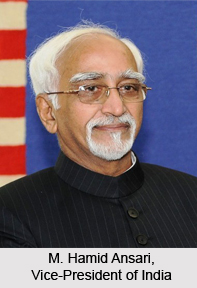 The Vice-President of India is the 2nd highest ranking official in the Executive Branch of the Indian Government. The Vice-President also has the legislative duty of being the Rajya Sabha Chairman. Currently, the Padma Shri award winner, M. Hamid Ansari is the Vice-President of India and he was elected on August 10th 2007. Article 63 of the Constitution of India provides for the office of a Vice-President who shall be elected indirectly in accordance with the system of proportional representation by means of a single transferable vote. The Vice-President will be elected by an electoral college consisting of the members of both Houses of Parliament. The legislatures of states, as in case of the election of President, have no part in the election of the Vice-President of India.
The Vice-President of India is the 2nd highest ranking official in the Executive Branch of the Indian Government. The Vice-President also has the legislative duty of being the Rajya Sabha Chairman. Currently, the Padma Shri award winner, M. Hamid Ansari is the Vice-President of India and he was elected on August 10th 2007. Article 63 of the Constitution of India provides for the office of a Vice-President who shall be elected indirectly in accordance with the system of proportional representation by means of a single transferable vote. The Vice-President will be elected by an electoral college consisting of the members of both Houses of Parliament. The legislatures of states, as in case of the election of President, have no part in the election of the Vice-President of India.
Qualifications of Indian Vice-President
The necessary qualifications for the office are that a person must be a citizen of India, over 35 years of age, must not hold any office of profit. He must also have the qualifications to be elected as a member of the Council of States. The last qualification which has been prescribed for the Vice President of India is that he should act as the Chairman of the Council of States.
A member of legislature or minister may be elected as the President or Vice-President provided he vacates his former office with effect from the date on which he joins his new office.
Functions of Indian Vice-President
Next to the President, the Vice-President is the highest dignitary of India. But it is an office without any specific functions associated with it. His normal duty is to act as the Chairman of the Council of State. In case of any vacancy in the office of the President of India by reasons of his death, resignation or removal, the Vice-President acts as a President till a new President is appointed and assumes office. Secondly, when the President is unable to discharge his functions owing to absence, illness or any other reason, the Vice-President will discharge the functions of the President till the latter resumes office. The Vice-President has been given the duty of presiding over the sessions of the Council of States.
The Vice-President of India is associated with some political as well as administrative nature. Sometimes the Vice-President is entrusted to carry on diplomatic negotiations with foreign legislations. But at the same time the Vice-President is not entitled to take a decision all by his own.
Tenure of Office of Indian Vice-President
The normal duration of the office is 5 years but it may terminate before either by resignation or removal. The Vice-President may resign by signing under his own hand addressed to the President of India. For his removal, a formal impeachment is not necessary as in the case of the President. A resolution for removal passed by a majority of members of the Council of States and agreed to by the House of the People are all that is necessary for his removal. The resolution of removal to be valid requires 14 days notice, before its introduction.
Re-election of Indian Vice President
The Constitution of India does not specifically provide for the re-election of the Vice President but is from the explanation in Article 66 that a sitting Vice-President may be re-elected as was done in the case of the Vice-President Radhakrishnan by electing him for the second term in the year 1957.
The President (Discharge of Functions) Act, 1969 provides that the Chief Justice or in his absence the senior most judge of the Supreme Court of India shall perform all the duties of the President in the event of simultaneous vacancies arising in the offices of the President and Vice-President of India.




















